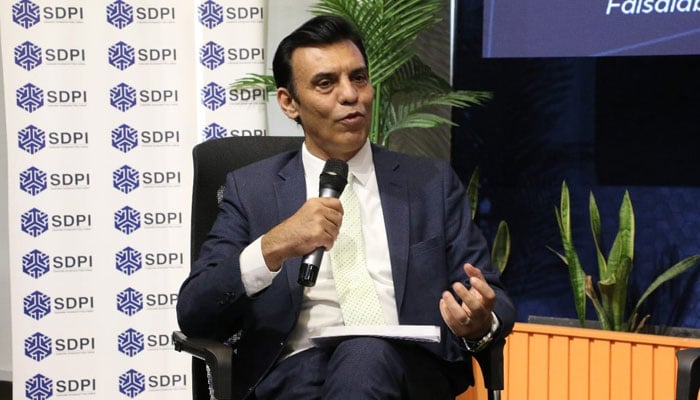‘Pakistan should achieve green hydrogen development capacity’
Islamabad: Dr Abid Qaiyum Suleri, Executive Director, SDPI, has called upon the experts, researchers, and students to work out investment and joint venture opportunities between Pakistani and Chinese firms under CPEC to achieve green hydrogen development capacity.
Dr Suleri was addressing a public private dialogue on “Exploring the potential of Green Hydrogen in hard to abate sectors of Pakistan” organised here by Sustainable Development Policy Institute (SDPI).
Dr Suleri said that almost 90 million tons of carbon is produced annually in the world that causes 800 million tons of CO2 emissions. However, there is a worldwide debate on making its production eco-friendly but the amount of energy required for this is a cost intensive enterprise.
He explained that hydrogen was of a different nature, ie, blue, green and pink. The blue hydrogen is produced by splitting methane gas molecules, the green hydrogen is by water hydrolysis and the pink hydrogen is produced through nuclear energy source.
The SDPI Executive Director underlined that that major challenge is the availability of electrolysers to produce hydrogen whereas the US is globally producing electrolysers while India and China are striving to produce efficient hydrolysers regionally.
Sardar Mohazzam, Managing Director, National Energy Efficiency and Conservation Authority (NEECA), said the hydrogen production is the future without any doubt as it was an inevitable source of energy in the prevailing growing climate change, population rise and energy demands. He stated that in order to achieve propitious transition, it is necessary to align the policy initiatives with the concept of hydrogen production, as it demanded a clarity of vision, policy, funding and regulations.
He maintained that funding is the main constraint in hydrogen production development, whereas a thorough stocktaking of daunting challenges like source of funding, private or foreign direct investment, processes to facilitate foreign investors in the sector and other issues needed to be sorted out prior to the policy roll out in the sector. Dr Irfan Ahmed Gondal, Head of Department at National Skills University, said hydrogen is a complex element that has issues with its usage and production whereas its production infrastructure is more important. Some 9,000 tons of hydrogen is required to replace 450 tons of coal running a system to produce steel or cement. Around 2,000 electrolysers of 10GW each are required for a factory. Hydrogen is a fanciful idea, but it is not feasible to produce in our system,” he said.
Abubakar Ismail from Amreli Steel said the steel industry has two production processes, namely the primary steel making done through ores in a glass finances, and the secondary steel making done through electric furnaces. However, the latter was a 70% less carbon intensive process than the primary steel making. He added that the majority of steel produced through secondary process was using electric furnaces that helped emit less carbon emissions.
Naheed Memon from Oracle Power said green hydrogen is the direction the world is travelling in. Memon maintained that it was imperative to maintain competitiveness in the process to promote green hydrogen production and penetration into the system. Pakistan has a huge opportunity to become part of the global supply of hydrogen as it has the resources to become legit supplier of these molecules in the region, she said adding that we need to produce these molecules competitively with cost efficient and better production processes that require policy, customisation and mobilised adaptation.
-
 Prince Harry Mentions Ex-girlfriend Chelsy Davy In UK Court
Prince Harry Mentions Ex-girlfriend Chelsy Davy In UK Court -
 David, Victoria Beckham 'quietly' Consulting Advisers After Brooklyn Remarks: 'Weighing Every Move'
David, Victoria Beckham 'quietly' Consulting Advisers After Brooklyn Remarks: 'Weighing Every Move' -
 Meta's New AI Team Delivered First Key Models
Meta's New AI Team Delivered First Key Models -
 Prince Harry Defends Friends In London Court
Prince Harry Defends Friends In London Court -
 AI May Replace Researchers Before Engineers Or Sales
AI May Replace Researchers Before Engineers Or Sales -
 Christina Haack Goes On Romantic Getaway: See With Whom
Christina Haack Goes On Romantic Getaway: See With Whom -
 Consumers Spend More On AI And Utility Apps Than Mobile Games: Report
Consumers Spend More On AI And Utility Apps Than Mobile Games: Report -
 Aircraft Tragedy: Missing Tourist Helicopter Found Near Japan Volcano Crater
Aircraft Tragedy: Missing Tourist Helicopter Found Near Japan Volcano Crater -
 Taylor Swift Lands In Trouble After Blake Lively Texts Unsealed
Taylor Swift Lands In Trouble After Blake Lively Texts Unsealed -
 'Prince Harry Sees A Lot Of Himself In Brooklyn Beckham'
'Prince Harry Sees A Lot Of Himself In Brooklyn Beckham' -
 Kate Middleton’s Cancer Journey Strengthens Her Commitment To Helping Children
Kate Middleton’s Cancer Journey Strengthens Her Commitment To Helping Children -
 Gaten Matarazzo Compares 'Stranger Things' Ending To 'Lord Of The Rings'
Gaten Matarazzo Compares 'Stranger Things' Ending To 'Lord Of The Rings' -
 Prince Harry Slams Publisher Over 'dirty Trick' Ahead Of Showing Evidence
Prince Harry Slams Publisher Over 'dirty Trick' Ahead Of Showing Evidence -
 Blueface Promises To Change Behaviour If His Ex Comes Back
Blueface Promises To Change Behaviour If His Ex Comes Back -
 Prince Harry Makes Crucial Promise To Meghan Markle Over UK Return
Prince Harry Makes Crucial Promise To Meghan Markle Over UK Return -
 Keir Starmer’s China Visit: UK Follows Mark Carney In Major Reset Of Ties
Keir Starmer’s China Visit: UK Follows Mark Carney In Major Reset Of Ties




